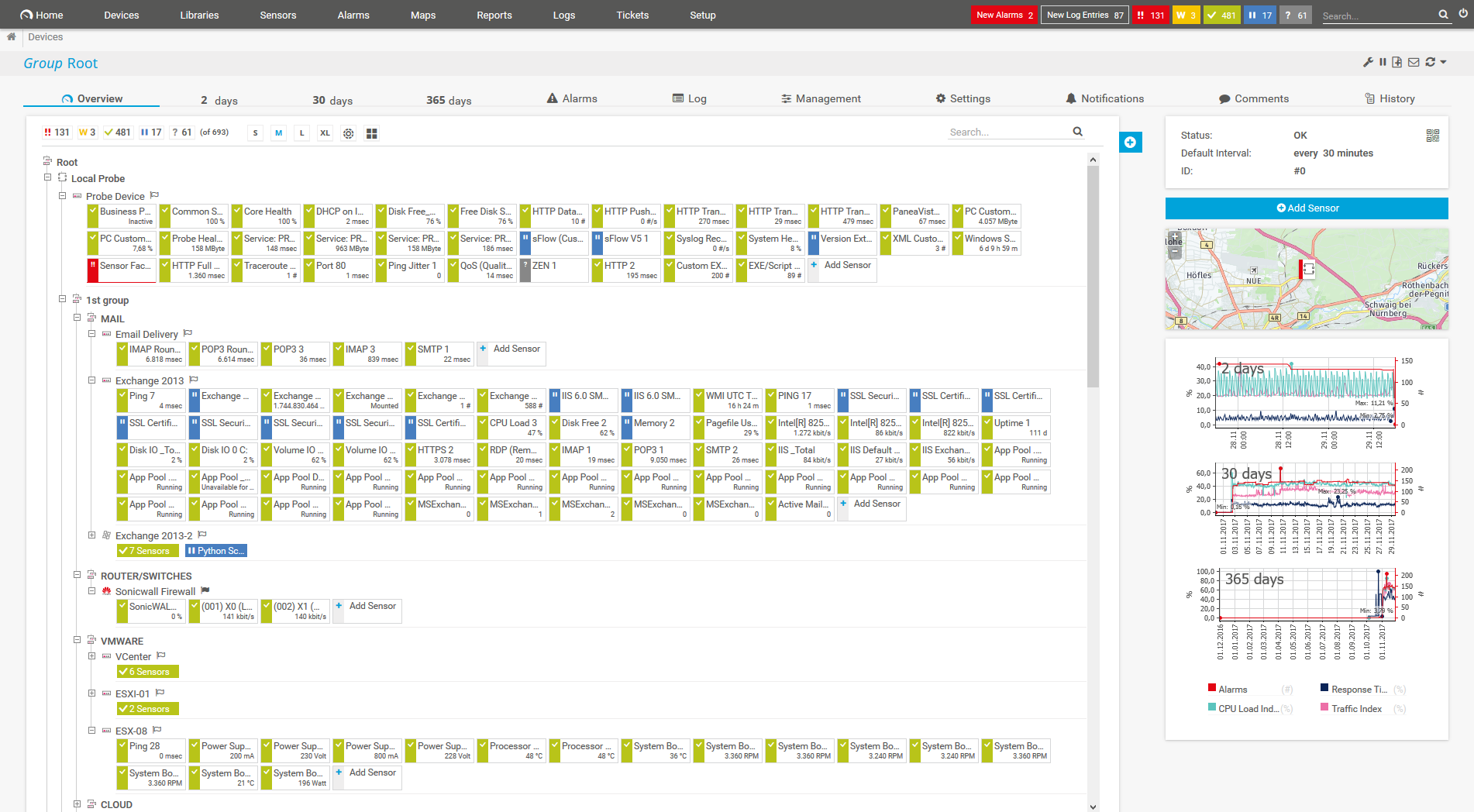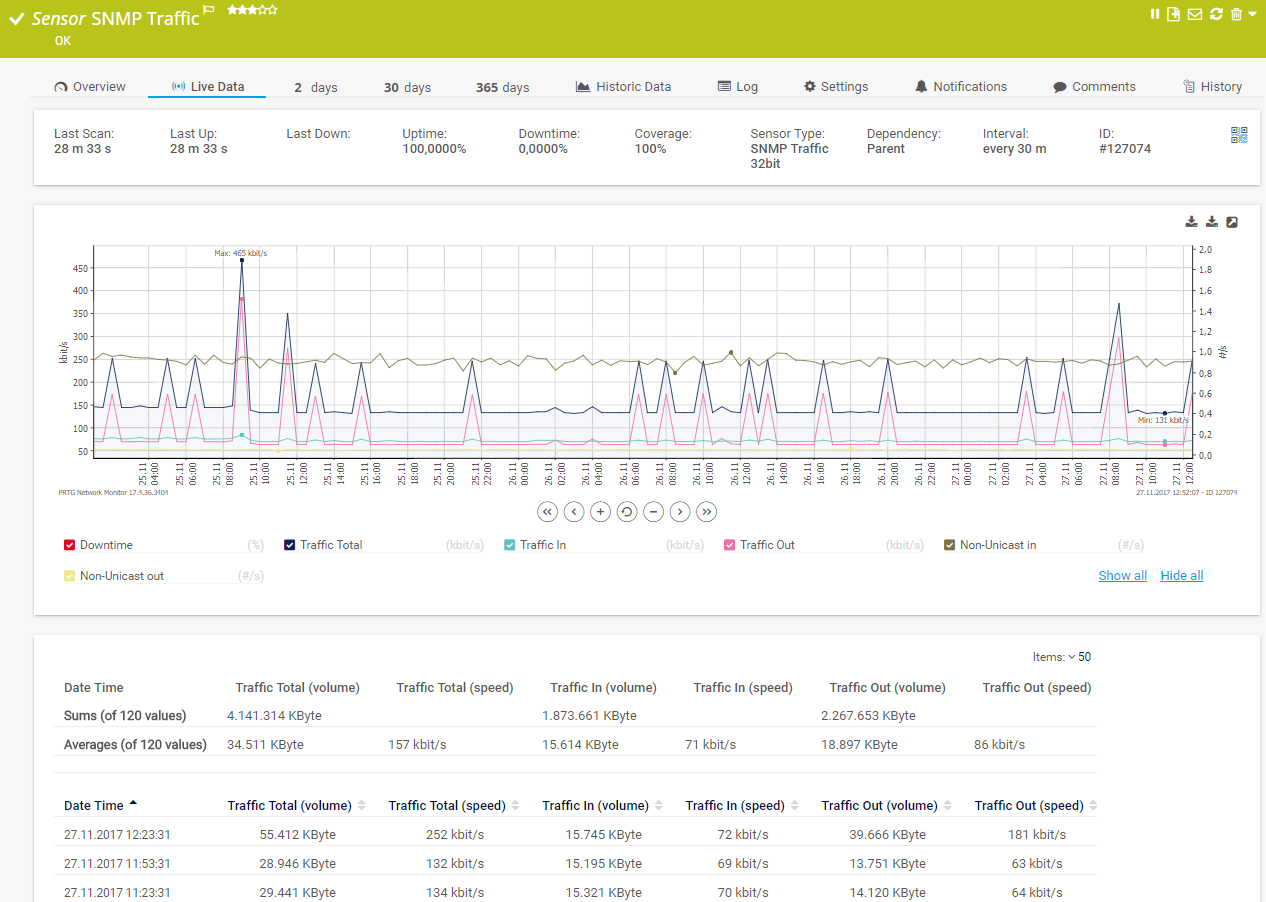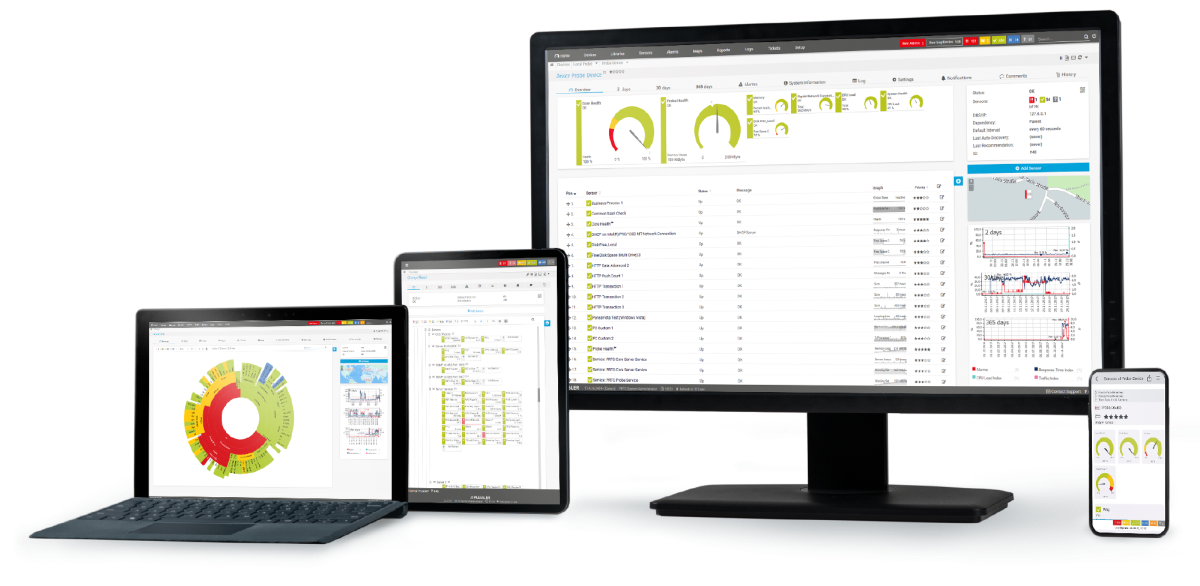Custom alerts and data visualization let you quickly identify and prevent all kinds of network issues.
Quick installation with automatic network discovery and smart setup for instant monitoring
Custom dashboard creation via drag & drop with easy-to-read visualized overviews
Different user interfaces for web, desktop, and mobile apps for monitoring on the go
Network of qualified implementation partners to support you with a smooth migration to PRTG
Diagnose network issues by continuously tracking the health, availability, and performance of your entire IT infrastructure. Show hardware parameters, application performance, network traffic, bandwidth usage, and other key metrics in real time. Visualize data in clear graphs and dashboards to identify problems more easily. Gain the overview you need to troubleshoot all kinds of issues in your network.

Device tree view of the complete monitoring setup

Custom PRTG dashboard for keeping an eye on the entire IT infrastructure

Live traffic data graph in PRTG
FEATURE | PRTG PRTG | Nagios Nagios |
|---|---|---|
One tool for your entire network | PRTG All monitoring features included | Nagios Core functionality for network monitoring, but requires add-ons and plugins for complete coverage |
Easy setup, intuitive monitoring | PRTG User-friendly interfaces for web, desktop, and mobile | Nagios Known for steep learning curve and complex configuration using text files |
Automatic network discover | PRTG Included | Nagios Available through Nagios XI or with additional plugins for Nagios Core |
Real-time alerts & notifications | PRTG Advanced, highly customizable alerting via different notification methods | Nagios Supports email, SMS, and custom notification scripts |
Custom maps & dashboards | PRTG Custom dashboard creation via drag & drop | Nagios Available in Nagios XI; limited in Core version and requires manual configuration |
Agentless monitoring | PRTG No need to install agents on the monitored systems | Nagios Supports agentless monitoring via SNMP, but many advanced checks require NRPE agent |
On-premises or cloud-based | PRTG Flexible deployment options available | Nagios Primarily on-premises, cloud deployment possible but requires manual setup |
Enterprise version | PRTG Available | Nagios Available as Nagios XI |
Freeware version | PRTG Available for up to 100 sensors, free for life | Nagios Nagios Core is open-source and free, but with limited features compared to XI |
Distributed network monitoring | PRTG Monitoring an unlimited number of remote locations included | Nagios Possible with distributed architecture setup, but requires additional configuration |
Server & application monitoring | PRTG Out-of-the-box integration, no extra cost | Nagios Core functionality, but many application monitors require additional plugins |
Network performance monitoring | PRTG Out-of-the-box integration, no extra cost | Nagios Basic capabilities in Core, advanced features require XI or additional plugins |
Bandwidth monitoring | PRTG Out-of-the-box integration, no extra cost | Nagios Available through additional plugins like NRPE or with Nagios Network Analyzer (separate product) |
Network traffic analyzer | PRTG Out-of-the-box integration, no extra costs | Nagios Requires separate Nagios Network Analyzer product (additional cost) |
Cloud services monitoring | PRTG Out-of-the-box integration, no extra cost | Nagios Limited native support, requires custom plugins or Nagios XI |
Virtual infrastructure monitoring | PRTG Out-of-the-box integration, no extra cost | Nagios Available through plugins, more comprehensive in Nagios XI |
Storage resource monitoring | PRTG Out-of-the-box integration, no extra cost | Nagios Basic monitoring in Core, advanced features require plugins or XI |
Database monitoring | PRTG Out-of-the-box integration, no extra cost | Nagios Available through plugins for major databases |
Web performance monitoring | PRTG Out-of-the-box integration, no extra cost | Nagios Basic HTTP/HTTPS monitoring in Core, advanced features in XI |
Supports leading technologies | PRTG SNMP, flow protocols, packet sniffing, WMI, HTTP, ping, SQL, and much more | Nagios Supports most standard protocols through Core and plugins, but may require additional setup |
Create your own scripts | PRTG Own PRTG API included for custom sensors and scripts | Nagios Supports custom plugins and scripts written in various languages |
Includes technical support | PRTG Expert support included, no extra costs | Nagios Community support for Core version; paid support only for XI version |
At first glance, Nagios open-source software seems considerably less expensive than PRTG. After all, why should you pay for something that you can get for free?
When it comes to software that you need to customize to meet the specific needs of a company, its purchase price is only a small factor if you consider its overall costs.
The initial setup of Nagios already takes a lot of time. Moreover, you can only install the tool’s free edition via Linux/Unix and all devices and checkpoints must be added using shell commands.
It is not uncommon for the setup to take several days, even for experienced Linux users. And if you need to customize your Nagios configuration later, you can count on spending an enormous amount of time and effort to get it done.
PRTG is configured in just a few quick clicks. Its auto-discovery function detects all devices and services in your network automatically and creates a first set of so-called PRTG sensors.
Adding, processing, and deleting sensors is straightforward and extremely intuitive thanks to an easy-to-understand user interface.
The time and energy that you spend configuring Nagios can quickly let operational costs go through the roof. At the end of the day, the seemingly free open-source tool is not really that inexpensive.
Nagios can be effective for small networks, and yes, the very basic version Nagios Core is available for free. It gets more complicated, however, if you need to manage larger environments. To set up Nagios correctly, you will need a lot of time and effort before reaching a professional standard, either by changing the source code, by using additional hardware, or by integrating various Nagios plugins and add-ons to scale the solution.
With PRTG, you won't waste countless hours reading forums and editing configuration files. After installing PRTG in just a few seconds, the smart setup assistant guides you through the setup and initial configuration. You can also use the auto-discovery feature to automatically create a comprehensive set of sensors for your entire network.
We would not put it as hard as Jonah Kowall does in his blog article: "Got Nagios? Get rid of it." And: "The level of usability and sophistication of the product (Nagios) is pretty much zero." But we, too, think that Nagios’s user interface is not very good and it’s definitely not very intuitive at all. PRTG, on the other hand, comes with a state-of-the-art, responsive web interface as well as smartphone apps for monitoring on the go.
You are interested to know if PRTG could be an alternative to your Nagios implementation?
As a system administrator, you must dedicate a great deal of time to the maintenance of your IT infrastructure, as this is the backbone of your company.
So let’s be honest: you could use the time that is needed to set up and maintain the operation of open-source solutions like Nagios or Zabbix in a much more efficient manner.
With the automated monitoring of PRTG, you are free to deal with other important tasks in your daily business.
Each PRTG subscription includes access to the latest PRTG version including new features and security improvements, as well as comprehensive technical support.
Moreover, our extensive Paessler Knowledge Base offers you precise answers to almost any issue that you might have. This way, you won’t have to spend hours browsing through online forums.
With PRTG, you’ll save both time and worry!
With Nagios, it can take days or weeks to get used to and customize the open-source software to meet the specific demands of your company and network.
People who configure and use Nagios need to have deep technical knowledge to do so. And if an IT professional who's also the Nagios expert leaves the company, other colleagues will usually have a hard time understanding how to use the tool.
By contrast, PRTG is also extremely easy to use for non-techies – even colleagues who were not involved in the setup process have no trouble getting the hang of the tool and the monitored network environment.
“PRTG totally blows away similar and popular server-based monitoring software, for example Nagios and Pandora FMS. Both of these competing applications were difficult to set up and use, and the interfaces felt poorly designed, hokey, and I couldn’t imagine using the interfaces of these products on a daily basis.”
PRTG is set up in a matter of minutes and can be used on a wide variety of mobile devices.

We also compared PRTG with other monitoring tools:
SolarWinds might be interesting for extremely complex network environments. But it also means you need to invest in higher costs for a platform made up of different modules and add-ons (that cost extra).
Zabbix is open-source software with a strong community support. But it requires lots of manual configuration work to install and set it up. You also need to install agents on the monitored systems.
PRTG and ManageEngine might seem similar at first. However, with ManageEngine, you have to choose between individual functions and purchase several modules to access the full range of features.
WhatsUp Gold might be your choice if you need good network mapping capabilities for networks which aren’t that complex. But to get the full set of monitoring features, you need to invest in costly add-ons.
Real-time notifications mean faster troubleshooting so that you can act before more serious issues occur.
Partnering with innovative IT vendors, Paessler unleashes synergies to create
new and additional benefits for joined customers.
By integrating PRTG with Martello iQ, you can add a fast analytics layer to improve uptime, visualize your IT environment, and integrate all of your IT systems into a single pane of glass.
Integrating monitoring results from PRTG into NetBrain maps makes the foundation for network automation.
Siemon and Paessler bring together intelligent building technology and advanced monitoring and make your vision of intelligent buildings and data centers become reality.
Network Monitoring Software – Version 25.3.110.1313 (August 27, 2025)
Download for Windows and cloud-based version PRTG Hosted Monitor available
English, German, Spanish, French, Portuguese, Dutch, Russian, Japanese, and Simplified Chinese
Network devices, bandwidth, servers, applications, virtual environments, remote systems, IoT, and more
Choose the PRTG Network Monitor subscription that's best for you
Choosing between Paessler PRTG and Nagios depends on several factors, such as your specific network monitoring needs, budget, and technical resources available in your organization.
If you only have Linux servers or prefer using open-source software, Nagios might be a good choice. For everyone who is looking for a powerful and easy-to-use monitoring software, PRTG Network monitor and PRTG Enterprise Monitor as on-premises network monitoring tools or PRTG Hosted Monitor as Paessler’s cloud-based version of PRTG is an excellent choice and more than just an alternative to Nagios.
PRTG is ideal:
Nagios might be your choice:
The basic version of Nagios is free of charge. But most users spent many hours to set up and customize the tool. In case of problems, browsing through forums is often the only solution. PRTG is not only set up in minutes, but you also save a lot of time in daily use.
Yes, PRTG has a Freeware Edition with which you get:
With the free version of PRTG, you can get started with network monitoring in a matter of minutes. Our Auto-Discovery feature detects all the devices within a given IP address range and automatically integrates them into your monitoring environment.
PRTG’s flexible subscription licensing makes it easy to scale as needed. You pay only for the number of sensors you need. After your 30-day free trial of the unlimited version of PRTG, you can still use the Freeware Edition with 100 free sensors. Or you upgrade to a paid license.
In PRTG, “sensors” are the basic monitoring elements. One sensor usually monitors one measured value in your network, for example the traffic of a switch port, the CPU load of a server, or the free space on a disk drive. On average, you need about 5-10 sensors per device or one sensor per switch port.
Paessler conducted trials in over 600 IT departments worldwide to tune its network monitoring software closer to the needs of sysadmins. The result of the survey: over 95% of the participants would recommend PRTG – or already have.
You are interested to know if PRTG could be an alternative to your Nagios implementation?